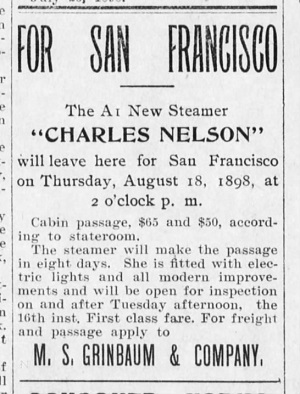

Portions of the 1st New York Volunteer
Infantry traveled from San Francisco California to Honolulu,
Hawaii aboard the transport
CHARLES NELSON. The CHARLES NELSON was
chartered for the single, one-way trip.
The vessel was smaller than most of the transports chartered by the Army Quartermaster Department and was definitely overcrowded on the trip.
The account below was written by someone from the 1st New York for the newspaper. The individual was not fully familiar with shipboard life. For instance the suggestion that the crew was trying to run out of coal is simply unlikely as without motive power the ship would unable to control the vessel in a storm and also would have caused the ship to pay the cost of a tow should a willing vessel be encountered. Also, the writer referred to the "ship's hole." This should be the "ship's hold." Regardless, the writer describes what was a very trying trip.
The Account:
The trip which our boys endured to Honolulu from San Francisco on the steamer CHARLES NELSON, was of a more perilous nature than people supposed. In the first place the NELSON is a boat considerably smaller than the HASBROUCK or MILLER, and was licensed to carry but 218 people. On board at the time were over 600 men including the including the officers and crew of the steamer. The rations had to be piled on top of the cabin roof, and many of the boys had to sleep there, using bags of potatoes as pillows. It was evident that the members of the crew were green at the business. The casks of drinking water was strapped to the side rail of the boat and before the steamer had been two days out the water became so warm that it was almost impossible to drink it. The ice and vegetables gave out early and the meat became tainted so that it was impossible to eat it. The men who were on the vessel did not hesitate to say that their food was stolen by the crew who were almost pirates. During the trip across the water the ship was on fire four times, each time the woodwork catching fire from the stack. One time the boat was stopped for nearly an hour while the crew fought the flames below the deck. When the officers of the military companies wanted to know about the cause of the delay they were told that nothing had happened, and the boat would proceed in a few minutes. This was repeated several times that the boat was stopped. Some of the soldiers stood ready to fight the members of the crew as they suspected that they were trying to delay the trip long enough to exhaust the coal supply. The boat was leaky too. Pumps were working continually, and when the boat reach Honolulu it is said that there were eight feet of water in the hole. If anything had happened during the trip it would have been impossible to save fifty men out of the 600 because the members of the vessel’s crew were not capable of performing their duties. They could not lower the boats as was demonstrated when one of the soldiers jumped overboard and a sailor was killed by the boat while trying to rescue him. The soldiers were more than glad when they reached Honolulu on safety...”

(As a service to our readers, clicking on title in red will take you to that book on Amazon.com)
"Banquet Tonight," Poughkeepsie Eagle-News
(Poughkeepsie, NY). December 29, 1898, 6.
"For San Francisco," The Hawaiian Star (Honolulu, Hawaii). August 16, 1898, 6. [the ad]